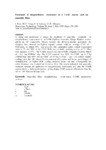Treatment of slaughterhouse wastewater in a UASB reactor and an anaerobic filter

Use this link to cite
http://hdl.handle.net/2183/13754Collections
- Investigación (FCIE) [1259]
Metadata
Show full item recordTitle
Treatment of slaughterhouse wastewater in a UASB reactor and an anaerobic filterDate
1997-06Citation
Ruiz I, Veiga MC, De Santiago P, Blázquez R. Treatment of slaughterhouse wastewater in a UASB reactor and an anaerobic filter. Bioresour Technol. 1997;60(3):251-8.
Abstract
A study was performed to assess the feasibility of anaerobic treatment of slaughterhouse wastewaters in a UASB (Upflow Anaerobic Sludge Blanket) reactor and in an AF (Anaerobic Filter). Among the different streams generated, the slaughter line showed the highest organic content with an average COD of 8000 mg/l, of which 70% was proteins. The suspended solids content represented between 15 and 30% of the COD. Both reactors had a working volume of 21. They were operated at 37°C. The UASB reactor was run at OLR (Organic Loading Rates) of 1–6.5 kg COD/m3/day. The COD removal was 90% for OLR up to 5 kg COD/m3/day and 60% for an OLR of 6.5 kg COD/m3/day. For similar organic loading rates, the AF showed lower removal efficiencies and lower percentages of methanization. At higher OLR sludge, flotation occurred and consequently the active biomass was washed out from the filter. The results indicated that anaerobic treatment systems are applicable to slaughterhouse wastewaters and that the UASB reactor shows a better performance, giving higher COD removal efficiencies than the AF.
Keywords
Anaerobic filter
Slaughterhouse wastewater
UASB
Ammonium
Proteins
Slaughterhouse wastewater
UASB
Ammonium
Proteins





